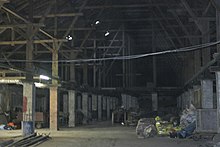Clinker factory
The brickworks was part of the Neuengamme concentration camp near Hamburg .
history
It was planned to develop Hamburg into a Führerstadt , with the banks of the Elbe being redesigned. For the facade cladding, it was decided to use clinker bricks , as they were common in northern Germany. The concentration camp in Neuengamme near Hamburg was built to produce these bricks . The factory was to be built and operated by prisoners. In the Vierlanden there was a sufficiently large area on which there was also a smaller, disused brick factory . The old brickworks were reactivated and clay was dismantled for the new factory.
On September 3, 1938, the SS bought the site in Neuengamme near Hamburg under the name “ Deutsche Erd- und Steinwerke ”. Less than a month later, 100 prisoners from Sachsenhausen camp arrived and Neuengamme became a satellite camp. In the months that followed, several new brick-making techniques were tried out, but most of them failed due to the quality of the clay.
On April 13, 1940, a contract was signed between the SS and the city of Hamburg, which stipulated the financing of the camp by the city of Hamburg and in return ensured that the city would be supplied with bricks from the camp for the planned new buildings. The commissioning of the western half of the new clinker plant was carried out on July 15, 1942. In the spring of 1943 the branch canal to the Dove Elbe was completed and the first transports were carried out by water.
In 1944 the SS built a factory for the manufacture of precast concrete parts for makeshift dormitories. This resulted in the so-called Hamburg panel houses .
Towards the end of the war, a production facility for aircraft parts was set up in the eastern part. The old brickworks were dismantled by the SS during the war.
After the war
When the Neuengamme concentration camp served as an internment camp after the war , the British troops let the German camp inmates work in the plant. After a few months almost all of the facilities were dismantled. Nothing is known about its whereabouts.
The buildings were sold and went to a Swedish company that set up a concrete factory there and made changes to the buildings.
After the company moved out, the halls were used for a long time as a winter place for boats. Boats were also lying in the branch canal in summer. Since no one was committed to the preservation of the building, it fell into disrepair and should be demolished in the 1980s. Although the Hamburg Senate had already decided to demolish it, protests from the population resulted in the brickwork being placed under monument protection. In the following years, the building was restored and the outside of the building was returned to its former condition. The concrete plant built in 1944 was demolished. The foundations still exist, but they are not visible.
The brickworks today
In the eastern part of the building there is an exhibition on the subject of "Work and Extermination: Concentration Camp Forced Labor in Brick Production". The western wing is empty and is used irregularly for larger events.
Due to the poor building fabric, the middle section is not accessible to the public. The cellar is under water, which is now pushing through the floor. The former Spar apartment can only be entered from the rear. It is in danger of collapsing and has large holes in the ground. The remaining facilities, such as some of the drying ovens, are quite well preserved and can be viewed from the exhibition. The former swamp basins are exceptionally well intact for their age, except for the structural changes that were carried out by the Swedish concrete company, they are still in their original condition.
As the old color and furnishings were partially preserved, a renovation for the public would be desirable, but so far there has been no financial means.
The former administration building now houses a psychological practice.
Individual evidence
- ↑ Labor and Destruction. The Neuengamme concentration camp 1938–1945. Catalog for the permanent exhibition in the document house of the Neuengamme Concentration Camp Memorial. Ed .: Ulrich Bauche , Heinz Brüdigam , Ludwig Eiber and Wolfgang Wiedey, 2nd revised edition, Hamburg 1991.
- ^ Fritz Bringmann , Hartmut Roder : Neuengamme. Repressed - Forgotten - Done? The "second" story of the Neuengamme concentration camp 1945–1985, Hamburg 1987
Web links
- Official website of the Neuengamme Memorial
- Neuengamme memorial in the Hamburg city information system
Coordinates: 53 ° 25 ′ 50 ″ N , 10 ° 14 ′ 1 ″ E





